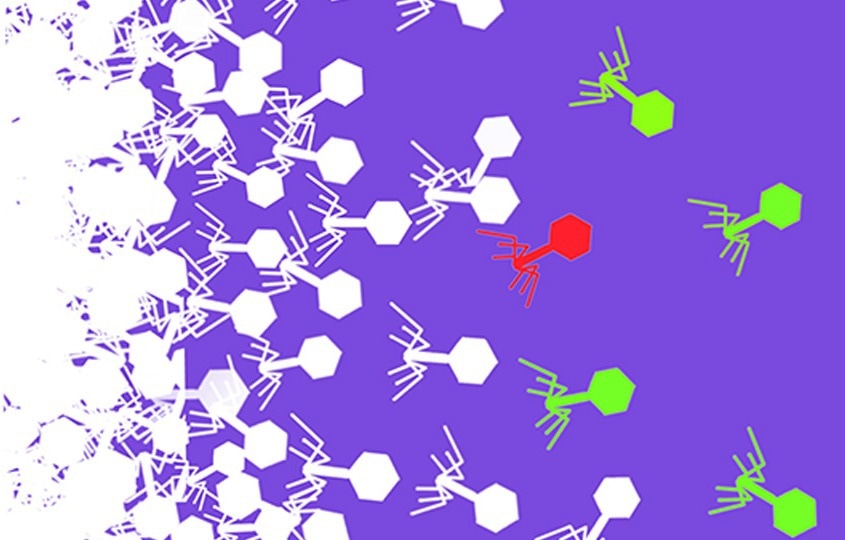At the grocery store, barcodes make it quick and simple to identify products and frequently contain important details like quantity, location, and tracking.

Image Credit: Vivek Mutalik/Berkeley Lab
Researchers at the Department of Energy’s Lawrence Berkeley National Laboratory (Berkeley Lab) have developed a rapid gene labeling or characterization scheme for bacteria-infecting viruses known as bacteriophages, or phages.
The scientists' approach, based on the CRISPR gene-editing technique that won the Nobel Prize, allowed them to determine which regions of a phage genome are crucial to its functionality. Barcodes placed in nonessential regions would enable researchers and medical professionals to rapidly recognize and monitor various phages in various environments once these regions have been identified.
When the technique is implemented on a larger scale, it could lead to the discovery of potent biotechnology uses in the fields of agriculture, the environment, human health, and more.
For instance, using the new barcoding technique, researchers will be able to follow phages as they are being used to alter the microbiome surrounding plant roots to promote plant growth during droughts or without the need for fertilizers. Additionally, they could monitor the use of barcoded phages in treating dangerous illnesses like infections resistant to antibiotics.
The impact of this work is immense. This report is the first studying gene essentiality at this scale in bacterial viruses.”
Vivek Mutalik, Corresponding Author and Staff Scientist, Biosciences Area, Lawrence Berkeley National Laboratory
The study published in PLOS Biology describes the method.
According to Mutalik and colleagues, the phage genes are necessary for bacterial infection on a genome-wide scale. It is referred to as “gene essentiality” by scientists. Furthermore, one type of phage can benefit from knowledge gained from another.
Mutalik says, “We use CRISPR interference (CRISPRi) technology to dial down almost every gene in two model phages for mapping the gene essentiality landscape. By knocking down expression of each gene at genome-wide scale, we can assess which genes in these two phages are important and which ones are dispensable for the infection cycle.”
CRISPRi has been successfully employed in both mammalian and bacterial systems, as highlighted by Mutalik. This breakthrough opens the door for conducting similar studies across various phages and facilitates the construction of genotype-to-phenotype mapping. This advancement offers valuable guidance for future innovators in the field.
Mutalik notes, “We also uncovered how phage genes are highly connected and that knocking down one gene impacts the expression of downstream gene, a phenomenon known as ‘polarity.”
Finding nonessential genes in phage genomes was the aim of this recent work, according to Mutalik, despite the fact that it may seem counterintuitive. Barcoding also plays a role in that.
The question was, once we identify a nonessential gene, can we replace that with some identifier – a unique tag. It’s like at a grocery store where you have barcodes on every item. Imagine somebody drops stuff all over the grocery store. How does the shopkeeper know where to go to put everything back? The shopkeeper can use the barcode to know which aisle, where, and so on. The barcodes help organize and standardize the entire workflow and help in how we handle different items in a collection. The same thing can happen with phage cocktails.”
Vivek Mutalik, Corresponding Author and Staff Scientist, Biosciences Area, Lawrence Berkeley National Laboratory
Mutalik continues, “Let’s say I make a phage cocktail – a mixture of phages with unique barcodes on them – to use in an application. But then we want to follow how phages are performing. To do this, we can simply find and track the barcodes. This process will help us find which phages in that phage cocktail are working and which ones are not. Imagine after five days we find that a particular phage mixture treatment is not working and needs some changes made. Then we can change the phage cocktail maybe by removing one or two phages and adding some more interesting ones that are better. Using barcoded phages will enable this entire process to be much more streamlined.”
The most prevalent biological species on Earth are phages. Though their gene-function information is largely unknown, they represent one of the greatest pools of genetic diversity found in nature.
According to Mutalik, the new CRISPRi characterization technique may open the door to a number of beneficial biotech applications, such as gene therapy, vaccine development, pathogen control in agriculture, environmental remediation, food and dairy production, and the removal of hazardous biofilms from medical devices that frequently accumulate and endanger both patient health and the device’s functionality.
The gene-function information for bacteriophages is like “an ocean of knowledge we don’t know how to tap into. On the one hand there is the untapped gene information, and then on the other hand there is the application space, for example, antibiotic resistance, where we need some urgent solutions. There are so many potential phage applications out there,” says Mutalik
However, Mutalik noted that phages have not been well described despite their potential. This is partially due to the fact that, given the vast array of phages, gene characterization techniques have, up until now, been labor-intensive and limited to specific phage types, rendering them useless.
If we want to study genomic architecture of hundreds of phages important in diverse applications, we need to improve these methods further.”
Vivek Mutalik, Corresponding Author and Staff Scientist, Biosciences Area, Lawrence Berkeley National Laboratory
In recognition, the “Phage Foundry” was recently funded by DOE’s Biopreparedness Research Virtual Environment (BRaVE) initiative, which supports national biopreparedness and response capabilities.
The Phage Foundry, led by Mutalik, combines multidisciplinary and multi-institutional expertise to create a foundational platform that unifies various facets of phage research, facilitating the quick development of targeted phage-based therapeutics against pathogens that are resistant to antibiotics.
Mutalik says, “The future is bright for phage research.”
Source:
Journal reference:
Piya, D., et al. (2023) Systematic and scalable genome-wide essentiality mapping to identify nonessential genes in phages. PLOS Biology. doi.org/10.1371/journal.pbio.3002416